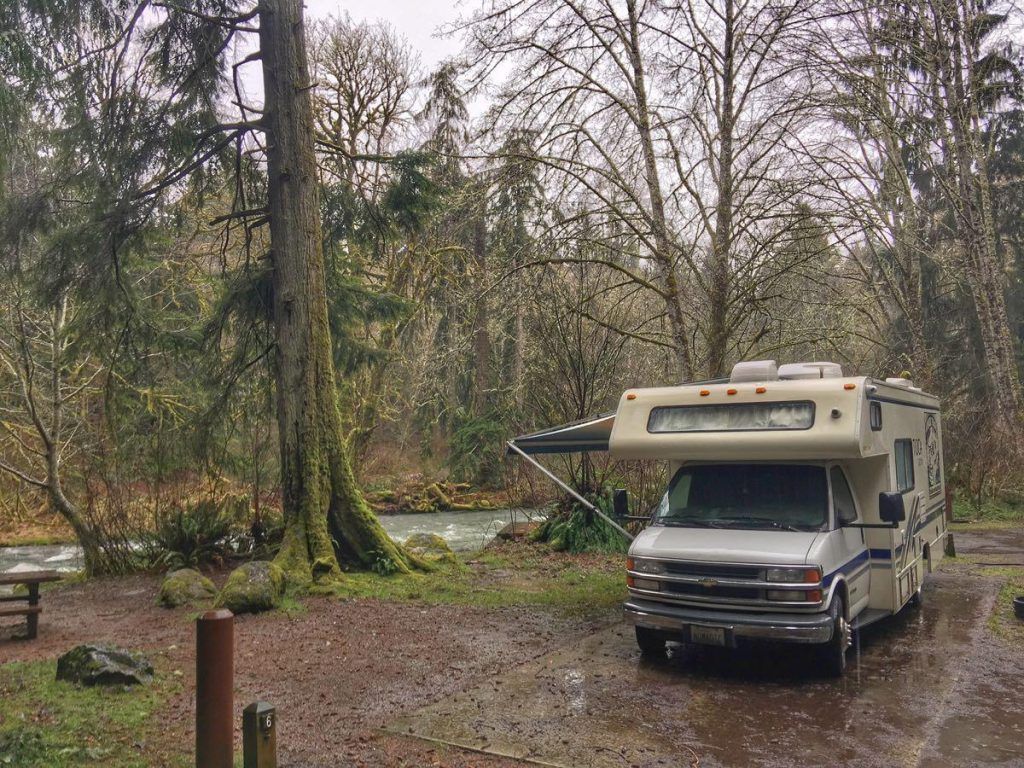In the past two installments, we have looked at equipping your new RV for its first campout. While you might choose a state park or private RV park for your first outing, I am going to share a tip of where to find free campsites that most RV newbies are unaware of.
Most every state has a department of natural resources (DNR) and a department of fish and wildlife (DFW) that manages state-owned land for the public.
While it would take a book to share the camping opportunities available in all 50 states, in this installment I will share the opportunities in my home state of Washington to give you an idea of what is available and an idea on where to look in other states.

DNR camping. Photo via Pinterest
Washington State DNR manages 5.6 million acres of forest, range, agricultural, aquatic, and commercial lands. These lands generate millions of dollars a year to support public schools, state institutions, and other services. The DNR seeks to provide outdoor recreation opportunities to the public throughout Washington State.
Recreation on DNR-managed lands includes hiking, hunting, fishing, horseback riding, camping, off-road vehicle (ORV) riding, mountain biking, and boating. DNR manages over 1,100 miles of trails, 143 recreation sites, and a wide variety of landscapes across the state. Examples of camping opportunities offered on DNR lands range from primitive sites among Eastern Washington sand dunes to developed forest campgrounds across the state. By clicking here you can view an interactive map of DNR-managed recreation sites which allows you to view campgrounds, trailheads, and day use areas.
Washington DFW Lands: Since 1939, the state has sought to preserve habitat for fish and wildlife by acquiring key areas for public ownership. Today, the Washington Department of Fish and Wildlife (WDFW) owns or manages nearly a million acres of land divided into 32 designated wildlife areas across the state. In addition to wildlife areas, WDFW also owns or manages more than 700 water access sites.
Wildlife areas
Washington’s wildlife areas are diverse in habitat and species offering many opportunities for wildlife viewing, hunting, fishing, hiking, and camping. With over 150 different areas to choose from, the choices for activities are abundant. While not all of the wildlife areas permit dispersed camping, many do, especially in Eastern Washington. Typically WDFW camping guidelines are as follows:
– Motor vehicles are allowed only on green dot roads with parking (camping) allowed within 100 feet of the road
– 21-day camping limit within a 30-day period
To find a wildlife area, click here. At the bottom of the page you will come across the “Find a Wildlife Area” box where you can search for a wildlife area by name, county, or region. If camping is not specifically listed at the wildlife area you plan to visit, contact the area manager. Contact information is listed in the left-hand margin. Complete rules can be viewed here.
Water Access Points
By clicking here, you can search a database of water access points managed by the WDFW which provide access to lakes, rivers, and marine areas. This link is great for those that want to find a place to fish, boat, or locate a waterfront campsite. You can search by site name, body of water, or county.
Clicking on one of the sites listed from your search will be provided with the following information: location (complete with coordinates and driving instructions), facilities (restrooms, boat ramps, docks, ADA access, etc), contact info, and most importantly, if camping is permitted or not! Quite often there is even a picture of the access site.
Note: Some states require a pass or permit to drive or camp on their lands, which can usually be obtained for a nominal fee. In Washington State you need a Discover Pass, or a vehicle pass, which comes with a hunting or fishing license to park or camp on WDFW land. Visit http://discoverpass.wa.gov/ to purchase a Discover Pass online or to find a vendor.
Be sure to take advantage of the thousands of opportunities to camp on state land across the United States during your travels. It is all part of the adventure in RVing!

In AZ you need a state land permit, $15 per year for 1 person, or $20 for a family. They have group rates for group activities. Go to their website. Having said that, AZ has a wealth of federal land, Forest Service, BLM, and other agencies as well. Compendium is a very good source of free campsites of all types, and have a lot of info an AZ among other states. Check their website. Also, although not free, several Indian Nations such as the Apache and Navajo, have tremendous recreational opportunities, but are not free. You need their permit. However, for what you get in return, the fees are not bad.
My 2 cents worth.